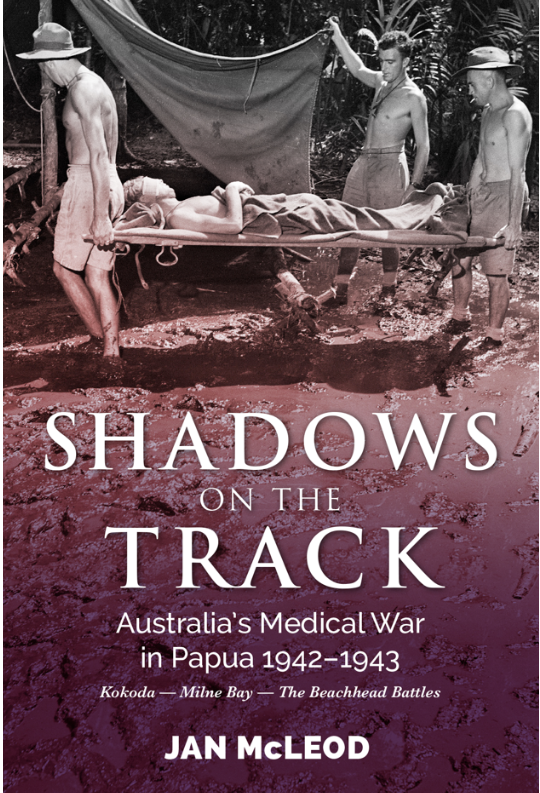McLeod begins her study with a strange, and to my mind irrelevant, discussion on the etymology of the Kokoda Track/Trail. Her book focuses on one aspect of medical support provided in this theatre in the New Guinea campaigns. The inclusion of Sir Kingsley Norris’s classic and eloquent description, which prefaces Allan Walker’s chapter on Kokoda in the official medical history, would have sufficed. There are other oddities such as that casualty statistics ‘lead to the inescapable conclusion that most of the Australian soldiers in Papua were cared for by medical personnel.’ I was left wondering who else would have undertaken this task?

Hardback 395pp RRP $34.99
Shadows on the Track sets out to examine issues that affected Digger’s health during the Papuan campaign. But it fails to do in this in any depth while also neglecting much contextual material that would have informed readers about the reasons behind the success or otherwise of the army medical services here.
The author provides a useful introduction to the background of the Army Medical Services and that Sir Raphael Cilento, a young Medical Officer in WWI, has been elevated to the status of official historian – something new, I think. The author neglects to mention his time as Director of Public Health in Papua prior to the war and the two works he wrote while there. While it is good to see another medical officer, Clive Disher (one of the unsung heroes of the AAMC) included here more could have been made of his contributions, as could those of Samuel Burston. The Australian Army’s involvement in New Guinea in 1914-14 is discussed but reference to works like Rob Likeman’s From the Tropics to the Desert (2012) would have done much to enliven this part of the book.
There is a good discussion of the pre-war lack of preparedness of the Australian Army and its medical services, but few references are made to the effects of the savage cuts to the defence budget in the 1920s and 1930s − most of which fell on the army. Little is said of the enemy, its medical establishment, or how the Japanese dealt with the health challenges in Papua. While Steven Bullard’s article, ‘The great enemy of humanity, malaria and the Japanese medical corps in Papua 1942-43′ (2006) is cited, other works such as Peter Williams’ thesis ‘The Kokoda Campaign, July-November 1942, An Analysis’ (Charles Darwin University, 2006) and Saburo Ienage’s The Pacific War: World War II and the Japanese, 1931–1945 (1978) would have considerably assisted McLeod in this respect.
Similarly, the medical disposition of our US allies and Australian engagement/cooperation in this theatre barely rates a mention. As the official history records: ‘The Australian sick and wounded owed a great deal to the American air transports’. The absence of any comparative analysis is a weakness in McLeod’s study and suggests a poor literature search. I can’t imagine for example why Henry Steward’s Recollections of a Regimental Medical Officer (1983) or Victor Austin’s To Kokoda and Beyond (1988) on the 39th Battalion are not cited.
In terms of contemporary or near contemporary medical studies published in the Australian Medical Journal there are only two references. This said, it is good to see the Army magazine Salt included as these pamphlets contain a wealth of information, particularly from the soldiers’ viewpoint. While from a medical perspective this was almost a stretcher bearers’ war, I got no real sense of the stretcher bearers and their officers or even those of the casualties in their care, as few personal narratives are included. Issues which were critical for these men, such as the controversy over Red Cross brassards and the difficulties experienced with Army-issue stretchers seem to be ignored.
But the most glaring omission is the absence of any real discussion of the psychological casualties of this campaign, a stark contrast to that provided in Condon Rall and Cowdrey’s comprehensive US study The Medical Services in the War Against Japan (1998) and which is cited by McLeod. Works such as John Raftery Marks of War: war neurosis and the legacy of Kokoda (2003) and David Wolley’s thesis,’ Not yet Diagnosed: Australian Psychiatric Casualties During the Kokoda Campaign, 1942′ (2017) are almost required reading nowadays on this aspect of the war. There are brief references to malingering and self -inflicted wounds but that is all. Similarly, much more could have been made of the importance of medical logistics, hygiene, laboratory work and the problems surrounding food and water, issues which generally are poorly addressed. This leaves McLeod’s overall study lacking balance and insight.
I thought that the 12 pages constituting chapter three could have be incorporated into the subsequent chapter to retain the narrative flow. Most of chapter two is given over to the Middle East conflict 1940-1 and its lessons, but the author devotes only two pages in analysing these. This is an unnecessary distraction and a structural weakness in the book. A positive though is the structure of subsequent chapters which deal with the health support provided during various phases of the campaign: withdrawal, advance etc, before dealing with specific operations on Kokoda and around Soputa. These are the author’s best chapters, covering as they do the situation of medical units and their preparedness or otherwise in each operation.
This work provides a useful counterbalance to the better known, indeed iconic stories of the ‘Fuzzy Wuzzy Angels’ which are often seen in popular works on the war in New Guinea. But there is little that is new here. Had the author produced something along the lines of Mark Johnston’s Stretcher Bearers: Saving Australians from Gallipoli to Kokoda (2015) her book would have been an accomplishment, but she fails to deliver an engaging or wide-ranging narrative. Disappointed as I was in Shadows on the Track, it is still a useful addition to the growing literature on Australia’s military medical history.
Reviewed for RUSIV by Michael Tyquin, May 2019
Contact Royal United Services Institute about this article.






